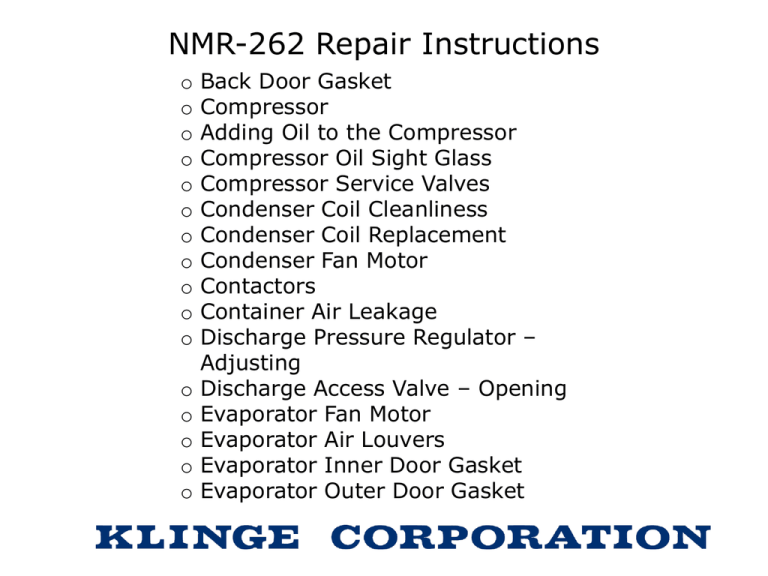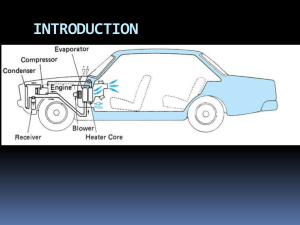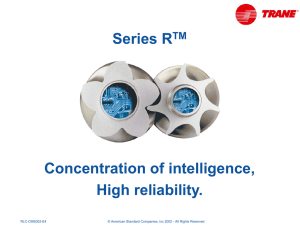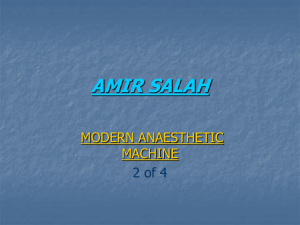NMR-262-Training-Pre..
advertisement

NMR-262 Repair Instructions o o o o o o o o o o o o o o o o Back Door Gasket Compressor Adding Oil to the Compressor Compressor Oil Sight Glass Compressor Service Valves Condenser Coil Cleanliness Condenser Coil Replacement Condenser Fan Motor Contactors Container Air Leakage Discharge Pressure Regulator – Adjusting Discharge Access Valve – Opening Evaporator Fan Motor Evaporator Air Louvers Evaporator Inner Door Gasket Evaporator Outer Door Gasket NMR-262 Repair Instructions o o o o o o o o o o o o o o o o o Filter Dryer and Moisture Indicator High Pressure Switch Hot Gas Solenoid Liquid Line Moisture Indicator & Filter Dryer Manifold Gauge Set Mega-Ohm Testing Non-Condensable Gases – Removal Quick Probe Replacement Receiver Refrigerant Leak Testing Suction Pressure Regulator - Adjusting Suction Access Valve – Opening Superheat Thermostat Labels Touchpad TXV Power Head Replacement Engine Control Unit Back Door Gasket The rear gaskets should be sprayed with a lubricating agent as needed to ensure they open and close without problems. Compressor Turn off main power to Reefer Unit. Swing control box open to gain access to compressor area. Hold control box in open position with a bungee strap. Evacuate refrigerant from the system (Follow Proper Procedure). Remove gauges after evacuation is complete. Disconnect the suction and discharge service valve assemblies from the compressor. Open junction box on top of compressor. Disconnect all wires and record how they are wired for easier reconnection. Unscrew cable gland from junction box and remove. Dismount the control box latch located at the bottom of the frame. Remove the four bolts that are mounting the compressor to the frame. Compressor (Continued) It is recommended to place wood blocks under the compressor and between the rails to help to easily slide the compressor out. When sliding out try to remove at an angle for easier removal. Get new compressor moved into place. Install four bolts mounting the compressor to the frame. Install cable gland and rewire the compressor. Close junction box. Pressurize system to check for leaks (Follow Pressure Check Procedure). Vacuum System (Follow Vacuum Procedure). Recharge system with refrigerant (Follow Recharge Procedure). Test unit to confirm successful replacement. Adding Oil to the Compressor Connect manifold gauges. Connect oil to the suction service valve. Connect pump to discharge service valve. Open high side manifold gauge. Close low side manifold gauge Turn pump on. Back seat both service valves Allow pump to pull oil into compressor. Compressor Oil Sight Glass During normal operation sight glass should be ¼ to ¾ full of Oil System must run for 20 minutes prior to checking oil level Compressor Service Valves Open to the system - with access to the service connection! Compressor Service Valves (Continued) Flow from the compressor to the Suction or Discharge line is stopped Closed to the system - with Compressor Pressure access to the service connection! Condenser Coil Cleanliness It has been noticed by Klinge Corporation that proper coil cleaning is not being performed on the condenser coils. Proper cleaning would help to increase the life of the coil fins and the overall performance of the unit. It is recommended that the condenser coils are washed on a quarterly basis. The proper procedure for cleaning the coils is to use an environmentally safe acid coil cleaner and a power washer. If water is not available then it is acceptable to us a high pressure air system (Nitrogen) to blow the dirt from the coils. NOTE: It is also recommended that the Generator Set radiator is washed twice per year. Condenser Coil Replacement Remove Reefer Unit from container. Remove coil guard. Evacuate refrigerant from both systems (Follow Proper Procedure). Condenser Coil Replacement (Continued) Unbraze lower piping joints. Unbraze upper piping joints. Remove condenser grill. Condenser Coil Replacement (Continued) Remove rear retainer bolts located in the rear of the condensing section. Remove rear retainer clip located in the rear of the condensing section. Condenser Coil Replacement (Continued) Remove coil cable guides located towards the top rear of the coil. Condenser Coil Replacement (Continued) Install new filter dryer/sight glass assembly (follow proper procedure). Install new coil from rear of unit. Install coil cable guides on top of coil. Reinstall rear retainer bolts and clip. Condenser Coil Replacement (Continued) Braze the lower and upper piping joints. Pressurize system to check for leaks (Follow Pressure Check Procedure). Vacuum System (Follow Vacuum Procedure). Recharge system with refrigerant (Follow Recharge Procedure). Reinstall front coil guards. Reinstall condenser grill. Remount Reefer Unit to the container. Condenser Fan Motor Turn off main power to Reefer Unit. Remove the condenser grill. Open junction box on the condenser motor. Disconnect the main power line wires (L1, L2, L3, L11, L12, L13 ). Unscrew the cable gland connectors from the junction box. Condenser Fan Motor (Continued) Unbolt the motor from the pedestal base. Slide motor out of condensing section. Make sure you do not cause and damage to the condenser coils. When the old motor has been removed try to remove the fan blade with a fan blade puller or you will need to install a new blade on the new motor. Condenser Fan Motor (Continued) Install new motor and fan back into the condenser section, ensuring not to damage the coils. Bolt the motor to the pedestal. Spin the fan blade by hand to ensure that the blade does not hit the shroud. If it does adjust the motor on the pedestal base. Reattach the cable glands and wires in the junction box. Turn the main power to the Reefer Unit back on. Turn the reefer unit on, as soon as the motor starts shut the unit off. Watch the fan blade to make sure it is spinning in the correct rotation. If the rotation is incorrect you will need to change the L1 and L3 wires. Recheck the rotation. Close the junction box and bolt shut. Reattach the condenser grill. Contactors Turn off main power to Reefer Unit. Unscrew all wires from the contactor. Release the old contactor from the DIN Rail by using a flat blade screw driver to activate the release clip. Clip new contactor onto the DIN Rail. Connect all wires and ensure all connections are tight. Container Air Leakage If you are noticing a large amount ice building up on the evaporator coil this is mainly caused by air leakage. Make sure that when entering the container the unit is turned off to minimize the pulling in of warm humid air. If the doors are not being opened and there is still air leakage happening it is recommended that the container be smoke bombed to find the air leaks. Opening the Discharge Access Valve Remove Valve Cap Turn CCW with wrench to back seat Adjusting Discharge Pressure Regulating Valve Remove Cap to Adjust Valve Schrader Valve Adjusting Discharge Pressure Regulating Valve (Continued) Unit must be on defrost for adjustment of setting Proper setting for R404a is ~ 240 to 270 psig Use 5/16 inch Allen wrench to adjust CW rotation increases pressure, CCW decreases pressure Replace cap after adjustment Evaporator Air Louvers Turn off main power to Reefer Unit. Open Evaporator Door. Use to door prop in the evaporator deck to keep the door opened. Reach arm in through the evaporator fan blade and press in the middle of the louver. This will cause the louver to bend enough that you can pull one side out of the retaining bracket. Louver When you install a new louver install one side of the louver in the bracket and then bend in order to get the other pin installed. Evaporator Fan Motor Turn off main power to Reefer Unit. Open Evaporator Door. Use door prop in the evaporator deck to keep the door opened. Evaporator Fan Motor (Continued) Open junction box on the evaporator motor. Disconnect the main power line wires (L1, L2, L3). Unscrew the cable gland connector from the junction box. Unbolt the motor from the pedestal base. Evaporator Fan Motor (Continued) Slide motor out of evaporator box with care. Make sure you do not cause and damage to any of the refrigeration piping. When the old motor has been removed try to remove the fan blade with a fan blade puller or you will need to install a new blade on the new motor. Evaporator Fan Motor (Continued) Install new motor and fan back into the evaporator section, ensuring not to damage any piping. Bolt the motor to the pedestal. Spin the fan blade by hand to ensure that the blade does not hit the shroud. If it does adjust the motor on the pedestal base. Evaporator Fan Motor (Continued) Reattach the cable gland and wires in the junction box. Turn the main power to the Reefer Unit back on. Turn the reefer unit on, as soon as the motor starts shut the unit off. Watch the fan blade to make sure it is spinning in the correct rotation. If the rotation is incorrect you will need to change the L1 and L3 wires. Recheck the rotation. Close the junction box and bolt shut. Evaporator Inner Door Gasket Open evaporator door. Use to door prop in the evaporator deck to keep the door opened. Remove the old door gasket from the inner door jam making sure to remove as much of the old material as possible. Inner Evaporator Door Gasket Install the new gasket material. You will need to apply contact cement or another type of adhesive since this gasket does not have an adhesive backing. Evaporator Outer Door Gasket Open evaporator door. Use to door prop in the evaporator deck to keep the door opened. Remove the old door gasket from the door making sure to remove as much of the old material as possible. Install the new gasket material which has an adhesive back. Evaporator Door Since the gasket is not a one piece formed gasket you need to start at the bottom of the door with the gasket. Then the bottom of the door is where the two ends of the gasket will meet which will help to prevent water from getting past the gasket. Evaporator Gasket Be sure not to kink the material around the corners, this will cause a bad seal resulting in air leakage. Filter Dryer and Moisture Indicator Screw in hand valve on receiver to stop the flow of refrigerant from the receiver. Hook gauges up to the suction and discharge service ports. Start the unit and monitor that the suction side goes into a vacuum and then turn the unit off. Moisture Indicator Filter Dryer Loosen the flare nuts on both sides of the filter dryer and moisture indicator assembly. Filter Dryer and Moisture Indicator (Continued) Reinstall the new filter drier and moisture indicator assembly. Make sure to use oil on the flare threads to help seal easier. Vacuum out the suction side of the system to a 30” vacuum and let stand with gauge turned to off to assure the flares do not leak. Open the receive hand valve to pressurize the system. High Pressure Switch (NMR-262-20 and Older) Note: For model NMR-262-20 and older. Remove junction box cover on top of the compressor. Unwire the pressure switch wires 29 and X2. Install gauges on suction and discharge service valves. Screw both service valves shut by turning the stems shut, which is the whole way in till the stem is short. Reclaim refrigerant from the compressor (Follow Proper Procedure). High Pressure Switch (NMR-262-20 and Older) Unscrew the pressure switch off of the 90 degree elbow on the head of the compressor. Install the new switch and then put the compressor on vacuum. While the compressor is on vacuum wire in the new switch to 29 and X2. NOTE: The newer units have a Schrader Stem in the elbows, evacuation will not be necessary on these units. New elbows can be purchased for the older units. Make sure there are three total wires connected to X2. X2 Wire (White), High Pressure Switch (Black), Solenoid Coil (Orange). Turn off the gauges and open both of the service valves. High Pressure Switch (NMR-262-22) NOTE: For model NMR-262-22 only. Remove junction box cover on top of the compressor. Unwire the pressure switch wires 29 and X2. Unscrew the pressure switch off of the 90 degree elbow on the head of the compressor. Install the new switch. Make sure there are three total wires connected to X2. X2 Wire (White), High Pressure Switch (Black), Solenoid Coil (Orange). Hot Gas Solenoid Turn off main power to Reefer Unit. Remove junction box cover on top of the compressor. Cut the orange wires loose from 19 and X2. Remove the cable gland from the junction box. Remove the screw from the top of the solenoid valve. Hot Gas Solenoid (Continued) Slide the solenoid coil off the top of the valve stem. Slide the new solenoid coil on the valve stem and attach the bolt. Wire the new wires with the existing 19 and X2. Make sure there are three total wires connected to X2. X2 Wire (White), High Pressure Switch (Black), Solenoid Coil (Orange). Liquid Line Moisture Indicator & Filter Dryer Check for moisture in system Observe color in sight glass. If yellow replace filter dryer and recycle the refrigerant. Run for 12 hours or until sight glass is green, and look for leaks on the suction side. If not green after 12 hours, replace filter dryer, recycle and look for leaks again. Manifold Gauge Sets (MGS) Low Side Gauge Compound Gauge High Side Gauge Low Side Hose Utility Hose High Side Hose MGS - Compound Gauge Positive Pressure Scale Built-in PT Charts Adjustment Screw Vacuum Scale (Reference Only!) MGS - Frontseated Each Gauge is isolated to it’s Hose! Low Side Hand Valve High Side Hand Valve MGS – Low Side Backseated Low Side Hand Valve High Side Hand Valve MGS – High Side Backseated High Side Gauge and Utility Hose open to High Side! Low Side Hand Valve High Side Hand Valve Purging a MGS If MGS is new, was exposed to atmosphere or used on a different refrigerant, you must purge them! Remove Compressor Service Valve Stem Caps and insure valves are fully backseated. Remove Access Port Caps. Install High Side Hose and Low Side Hose. Purging a MGS Do Not Connect the Utility Hoses. Backseat the high side MGS hand valve. Leave low side MGS hand valve frontseated. Open Discharge Service Valve - 1/4 turn. Use purge fitting to purge contaminants from utility hose. Frontseat high side MGS hand valve. Repeat process for low side. Installation of MGS Remove Compressor Service Valve Stem Caps and insure valves are fully backseated. Remove Access Port Caps. Frontseat MGS hand valves. Install High Side Hose. If MGS has positive pressure and was used for the same refrigerant, purging is not necessary. Installation of MGS Install Low Side Hose. Connect Utility Hose to MGS dummy port. Midseat Discharge Service Valve - 1/4 turn Midseat Suction Service Valve - 1-2 turns. Gauges are now installed and ready for checking system pressures! Removal of MGS With the unit operating. – Backseat the Discharge Service Valve. – Midseat the MGS Hand Valves. – Let the pressure in the MGS stabilize to Suction Pressure. – Frontseat the MGS Hand Valves. – Backseat the Suction Service Valve. – Remove Hoses. Low Side Pump-down Purpose To perform general service on the Filter-drier, Modulation Valve, Suction Solenoid Valve, Heat Exchanger and TXV Valve. Procedure Install Manifold Gauge Set. Operate unit in Cool Mode for 15 - 20 minutes. Close the Liquid Line Hand Valve. Monitor the Low Side Gauge and shut unit OFF when it reaches a slight vacuum (5” hg max.). Monitor the Low side gauge: • Pressure rises above 2-3 PSIG - pump down again! • Pressure does not rise above 2-3 PSIG - continue! Front-seat the Suction Service Valve. All Refrigerant is now trapped in the Condenser and the Receiver tank! Manifold Gauges hooked up to Monitor Refrigerant Pressures Refrigerant Charging with Manifold Gauges Cylinder Valve R404a refrigerant cylinder You can now service: Mega-Ohm Testing Purpose: test motor insulation with high Voltage DC – A Go-No-go proof test of motor insulation – Megger will produce voltage pulse and indicate pass or fail – Used to check compressor and fan motors Three basic types: Hand crank, line operated and battery Test Voltage: – Device rating up to 100 Vac – test voltage is 100 to 250 Vdc – Device rating 440 to 550 Vac – test voltage is 500 to 1000 Vdc – Device rating 2000 Vac – test voltage 1000 to 2500 Vdc Caution: Never touch test leads during test and electrically isolate the motor being tested Mega-Ohm Testing (Continued) • Record nameplate information • Select test voltage • To test insulation between lead and earth ground, connect 1 terminal to the lead and the other to a good earth ground • To test between a winding and frame, connect 1 terminal to the lead and 1 terminal to ground • Test L1, L2 and L3 • For hand crank megger, turn at ~ 160 RPM • Megger will indicate pass or fail • Record test results, test every 8 to 12 months Removal of Non-Condensable Gasses Existence of Non-Condensable Gasses is the major cause of high discharge pressure. Air and Non-Condensable Gasses collect at the top of receiver. Refrigeration reclaim equipment must be connected to the purge valve on the receiver . Hose from reclaim equipment must be able to depress Schrader valve. Remove small amount of refrigerant through reclaim device Observe discharge pressure for 5 minutes. Repeat until discharge pressure is normal, saturated discharge pressure should be 11 to 17 degrees C above the ambient. If discharge pressure fails to return to normal, reclaim refrigerant charge, pump system into a vacuum and recharge with refrigerant. Quick Probe Replacement Turn off main power to Reefer Unit. Open evaporator door. Use to door prop in the evaporator deck to keep the door opened. Unbolt clamps from probe wire and pull defective probe out of its holder in the evaporator coil. Cut the probe and the wire approx 6 inches from the end of the heat shrink on the probe. Splice new probe to the existing cable and reinstall in its original location. Return Probe Probe Clamps Defrost Probe Bolt the clamps to the probe wire. Receiver Turn off main power to Reefer Unit. Evacuate refrigerant from the system (Follow Proper Procedure). Loosen flare nuts from filter drier and moisture indicator assembly and remove. Unbraze the ½” pipe from the top of the receiver. Receiver Remove the bolts holding the receiver to the side wall of the unit. Receiver (Continued) Remove hand valve from old receiver. Install hand valve on new receiver. Braze elbow into new receiver. Bolt receiver to the side wall of the unit. Install new filter dryer/moisture indicator assembly (Follow Proper Procedure). Reconnect piping to the new receiver. Pressurize system to check for leaks (Follow Pressure Check Procedure). Vacuum System (Follow Vacuum Procedure). Hand Valve Recharge system with refrigerant (Follow Recharge Procedure). Special Note: When brazing dissimilar metals you need to use special brazing rod. Refrigerant Leak Testing Check all joints and fittings The preferred method for leak detection is use of an electronic leak detector Leak testing with soap suds will reveal only larger leaks Portable electronic leak detectors are usually used for field testing. Opening the Suction Access Valve Remove Valve Cap Turn CCW with wrench to back seat Adjusting Suction Pressure Regulating Valve Right Side Suction Pressure Regulator & Hot Gas Valve Electrical connection to Solenoid of Valve Hot Gas Valve Remove cap to adjust suction pressure regulator valve Electrical cable to compressor junction box Adjusting Suction Pressure Regulating Valve (Continued) • • • • • • • Box temp should be above 5°C Setting should be ~ 30 to 35 psig for R404A Use 5/16 inch Allen wrench to adjust 1 turn changes setting by 2.5 psig CW rotation increases pressure, CCW decreases pressure Run system 15 minutes to confirm setting Be sure to replace cap Super Heat - Expansion Valve Adjustment Super Heat - Expansion Valve Adjustment (Cont) KLINGE CORPORATION Super Heat - Expansion Valve Adjustment (Cont) KLINGE CORPORATION Thermostat Labels Operator Label The revision level can be found on both of the front and side label. The front label is used for normal operation. Revision Level Thermostat Labels (Continued) The side label is used for function test procedure only. Touchpad Turn off main power to Reefer Unit. Unclip the ribbon cable from the back of the touch pad. Remove the touch pad base that the touchpad is installed in. On the back of the touchpad remove the four nuts that hold it to the touch pad base. Remove touch pad from the base. Install new touchpad and four nuts. Screw touch pad base back onto the sub panel. Clip the ribbon cable back onto the back of the touchpad. Touchpad Turn off main power to Reefer Unit. While releasing the locking tabs on the Thermostat Block pull the Thermostat straight out towards you. Unclip the ribbon cable. Clip the ribbon cable into the new Thermostat. Push the new Thermostat into the Thermostat Block until secure. Turn main power back on to the Reefer Unit. Perform Function Test to ensure the new Thermostat works properly. TXV Power Head Replacement Hook up gauges to the suction and discharge service valves to be able to monitor pressures. Turn the hand valve on the receiver in to stop the flow of refrigerant to capture the Refrigerant in the receiver and condenser coil. TXV Power Head Replacement (Cont) Turn the unit on and monitor the suction pressure into a vacuum. Once in a vacuum turn the unit off and continue to monitor for approx 10 minutes to assure the vacuum stays. If after 10 minutes the vacuum is still present turn the high side service port in to guarantee no refrigerant back-flowing through the compressor. Open Evaporator Door. Use to door prop in the evaporator deck to keep the door opened. Remove cork insulation tape from the suction line in the evaporator section. TXV Power Head Replacement (Cont) Loosen the clamps holding the power head bulb in place on the suction line. Using two wrenches hold the TXV body with one wrench and with the other wrench loosens the power head from the top of the TXV. Install the new power head element and tighten. TXV Power Head Replacement (Cont) Reinstall the bulb on the suction pipe assuring that the bulb is located at a 4 or 8 O’clock position on the pipe. Re-insulate the bulb with cork tape or some other insulation material. The insulation on the bulb is VERY critical to ensure proper operation. TX Valve Bulb Bracket TXV Power Head Replacement (Cont) Install new filter dryer/moisture indicator assembly (Follow Proper Procedure). Vacuum the suction side of the unit to 30” vacuum and then shut down the vacuum pump. Then release the Refrigerant from the receiver and open the discharge valve. NOTE: Under pressure in the system must be avoided since a little air in will cause more problems than a little refrigerant out. This Unit Is Equipped with an Engine Control Unit (ECU) KLINGE P / N K31 00826 00 THE ECU AUTOMATICALLY CRANKS, STARTS & MONITORS ENGINE FOR OVERCRANK, OVERSPEED, HIGH COOLANT TEMP, & LOW OIL PRESSURE. THE ECU IS LOCATED IN THE ELECTRICAL BOX AND USES SIGNALS FROM A MANGETIC PICKUP P/N K25 26241 02 TO MONITOR ENGINE DURING CRANKING & RUNNING. THE MAGNETIC PICKUP IS LOCTED CLOSE TO THE BOTTOM OF THE ENGINE’S FLYWHEEL HOUSING & IS CONNECTED TO THE CONTROL BOX BY SHIELDED 2 CONDUCTOR CABLE. IF THE SIGNAL FROM THE PICKUP IS NOT RECEIVED DURING CRANKING, ENGINE WILL NOT START. IF THE SIGNAL IS LOST WHEN UNIT IS RUNNING, ENGINE WILL SHUT OFF. IN BOTH CASES THE OVERCRANK & OVERSPEED LED’s OF ECU WILL ACTIVATE. KLINGE CORPORATION ECU KLINGE P / N K31 00826 00 (Cont) FOR PROPER OPERATION THE GAP BETWEEN THE TOP OF THE MAGNETIC PICKUP & THE TOP OF THE ENGINE’s FLYWHEEL SHOULD BE 0.53 mm. THIS GAP IS OBTAINED BY INSERTING THE PICKUP UNTIL IT LIGHTLY TOUCHES A FLYWHEEL TOOTH & THEN BACKING IT OUT BY ½ A TURN. TO MAKE SURE THIS GAP IS MAINTAINED, CHECK FROM TIME TO TIME THAT THE LOCKNUT ON THE MAGNETIC PICKUP IS TIGHT. KLINGE CORPORATION ECU KLINGE P / N K31 00826 00 (Cont) IF THE SIGNAL FROM THE PICKUP IS NOT RECEIVED DURING CRANKING, ENGINE WILL NOT START. IF THE SIGNAL IS LOST WHEN UNIT IS RUNNING, ENGINE WILL SHUT OFF. IN BOTH CASES THE OVERCRANK & OVERSPEED LED’s OF ECU WILL ACTIVATE. IT THE MAGNETIC PICKUP MUST BE REPLACED MAKE SURE THAT DURING INSTALLATION IT FACES THE HIGHPOINT OF A FLYWHEEL TOOTH, TO ENSURE THIS USE A FLASH LIGHT TO LOOK THROUGH THE MOUNTING HOLE & SLIGHTLY TURN ENGINE UNTIL HIGHPOINT OF A TOOTH FACES THE HOLE. THERE ARE 4 POTS TO ADJUST THE CONTROL SETTINGS & 5 SWITCHES TO SET THE CRANK CYCLES AS SHOWN IN THE SKETCH. TURNING THE POTS CLOCKWISE INCREASES THE SETTINGS, POTS ARE 25 TURNS AND CAN NOT BE DAMAGED BY EXCESS TURNS. SWI, SW2 & SW3 SHOULD BE ON, SW4 & SW5 SHOULD BE OFF.







